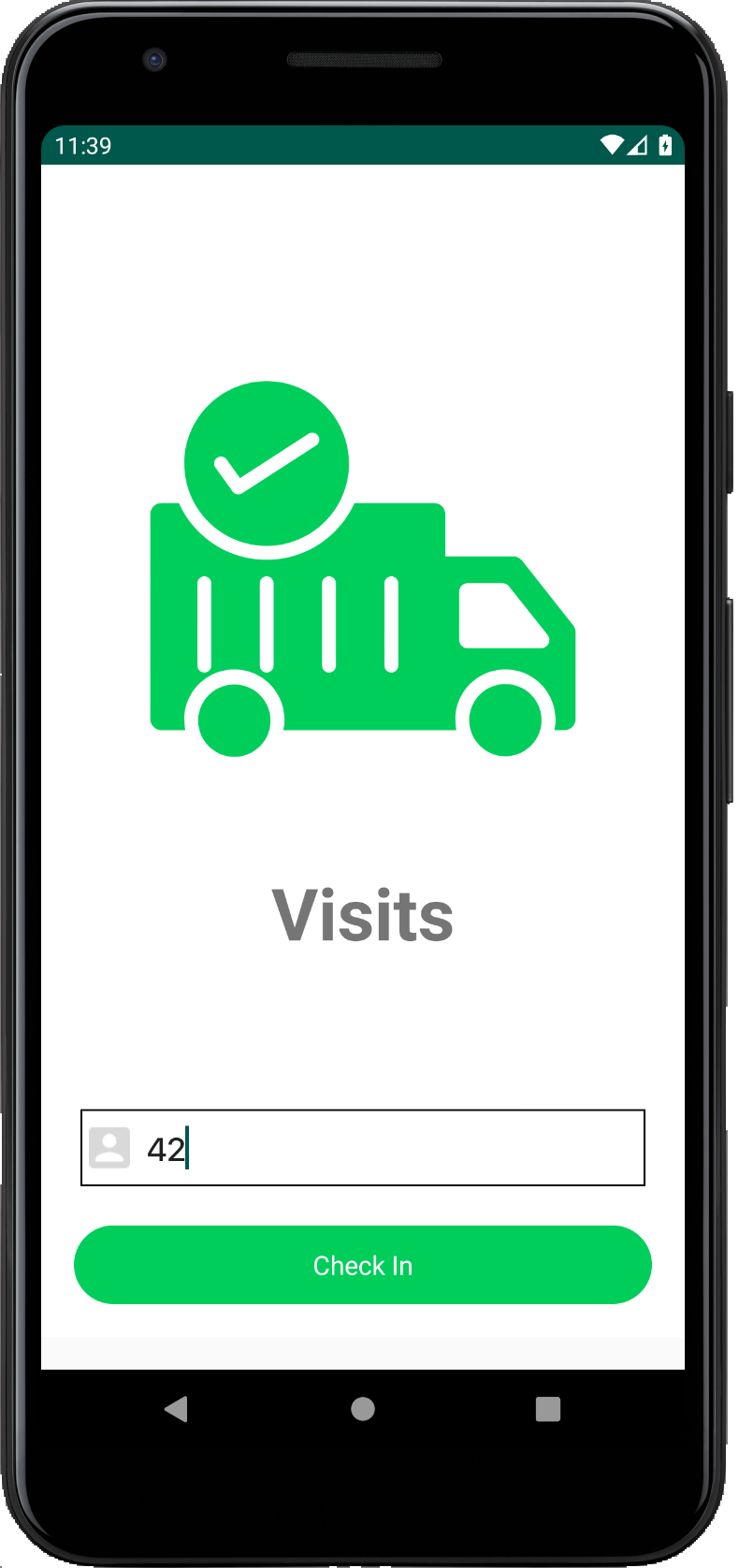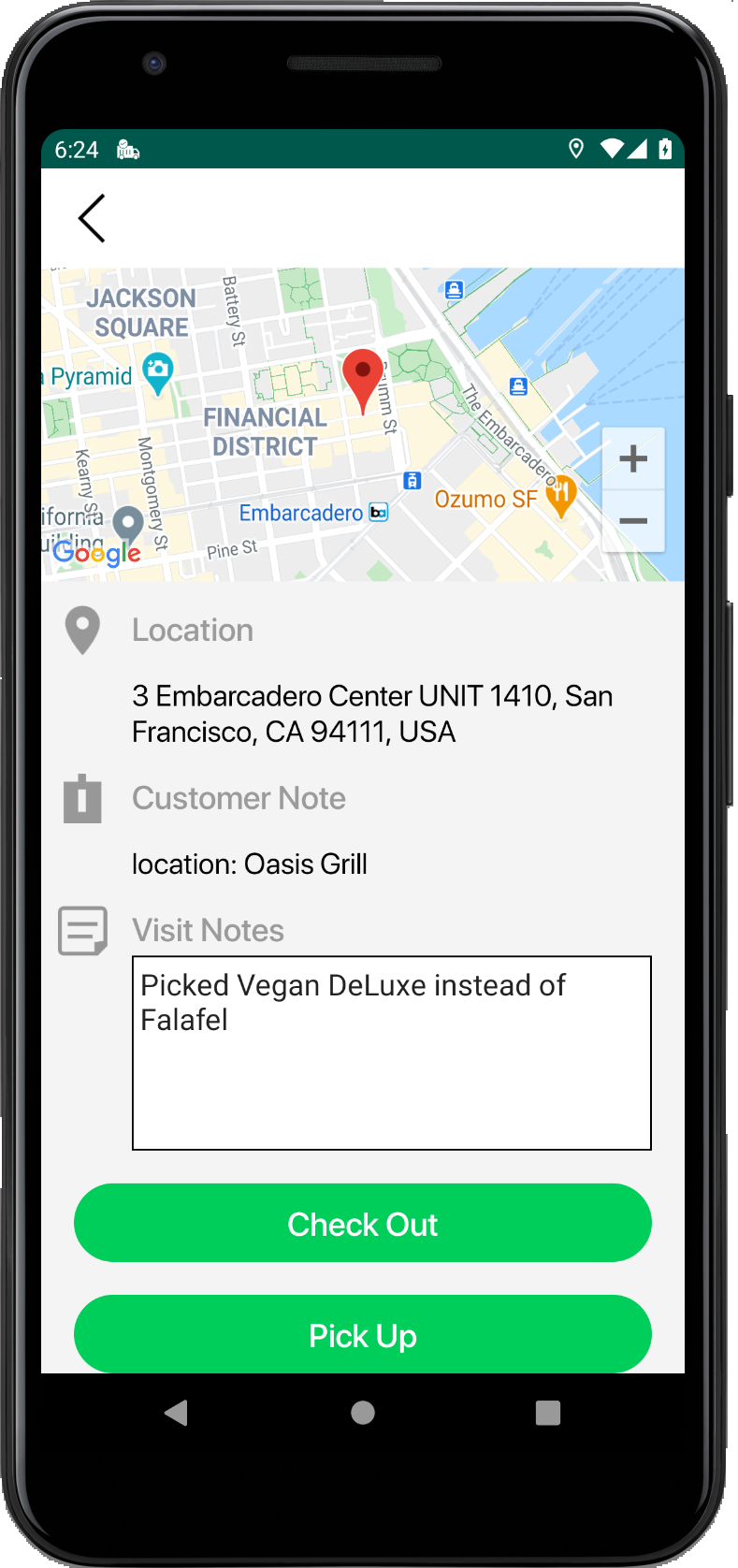👉 Looking for the iOS version?
This is an open-sourced logistics application (also available in Google Play) built using HyperTrack for live location tracking. This app enables logistics fleets to manage their deliveries for the day. The app assigns deliveries to the driver, tracks live location, geofences arrival at a delivery location, and allows to add delivery notes and mark the delivery as complete. Fleet managers and teams can track the day's deliveries for all drivers in real-time on HyperTrack Views.
| Driver Checkin | Overview of Deliveries | Delivery Details |
|---|---|---|
 |
 |
 |
- Handle permission requests required for live location tracking
- Track day's deliveries as geofences on HyperTrack
- Automatically update arrival, exit and current delivery to make driver productive
- Create custom markers with delivery notes and for delivery completion
- Update delivery status to indicate time spent at the delivery destination using geofence webhooks
This app is using HyperTrack geofences, which come with powerful views on the HyperTrack Dashboard to:
- Track all devices associated with your HyperTrack account on a map in real-time
- Review all delivery details, including: delivery locations, time spent and route to each delivery
- Review custom markers with delivery notes and delivery completion to answer support tickets
You can roll out the apps to drivers first and integrate backend later or do it the other way around.
Every time a driver installs the app and enters his driver_id a new device_id is created. Query GET /devices API to obtain a list of all app installs made by your drivers:
curl "https://v3.api.hypertrack.com/devices" \
-u '{AccountId}:{SecretKey}'AccountIdandSecretKeyare API keys and can be obtained in the dashboard's Setup page
You will get a response similar to the following (check out all possible fields in our API Reference:
[
{
"device_id": "DEADBEEF-DEAD-BEEF-DEAD-BEEFDEADBEEF",
"registered_at": "2019-07-26T09:00:00Z",
"metadata": {
"driver_id": "driver@your_business.com"
}
...
}
]Use the driver_id field to match a driver to a record in your system. Associate and store the device_id in your datastore. This identifier is important and it is used throughout HyperTrack APIs to identify devices. See this guide for more about device management.
Run this query every time you expect drivers to install the Visits app. We recommend to make a query at the start of each working day before delivery assignment. This way your system will always be in sync with the app.
Apps can be reinstalled or installed on multiple phones, which can result in multiple devices with the same metadata but different device_ids. If you expect your drivers to only use one mobile phone with the app installed, update your user record with device_id having the latest registered_at value and delete the no longer needed device_id from HyperTrack. The deleted device_id won't be able to accidentally track and won't be billed for your account going forward, but the tracking data will be saved.
curl -X "DELETE" "https://v3.api.hypertrack.com/devices/{device_id}" \
-u '{AccountId}:{SecretKey}'Every time you assign a delivery to a driver in your system create a geofence at customer's location.
curl -X "POST" "https://v3.api.hypertrack.com/geofences" \
-u '{AccountId}:{SecretKey}' \
-d $'{
"device_ids": [
"DEADBEEF-DEAD-BEEF-DEAD-BEEFDEADBEEF"
],
"geofences": [
{
"geometry": {
"type": "Point",
"coordinates": [ -122.395223, 37.7947633]
},
"radius": 100,
"metadata": {
"Customer Notes": "Please deliver before 10 AM",
"Message": "Use back door to enter."
}
}
]
}'device_idis the HyperTrack's id associated with your drivergeofencesyou can assign multiple deliveries for the same driver at once by having multiple objects in this arraygeometryis a geometry of a geofence with circular represented by "Point" value and polygon as "Polygon". Both types are represented in GeoJSON format where coordinates have longitude as a 0'th element and latitude as 1'stradiusis the radius for a circular geofence type. We suggest radius at least 100 meters to account for a driver meeting a customer outside of the buildingmetadataYou can add any number of fields in the form"string key": "string value"and the app will display them in the UI. You can also include non-string values, the app will ignore them, but you can use them later when querying the data or receiving events from webhooks.
Response:
[
{
"geofence_id": "deadbeef-dead-beef-dead-beefdeadbeef",
"created_at": "2020-05-26T09:00:00.000Z",
...
}
]geofence_idthe ID of a newly created geofence. Associate it with your delivery and store it in your datastorecreated_attimestamp when geofence was created. Visits app uses this timestamp to order deliveries from oldest to newest
The geofence will be represented as a delivery on a driver's app. The delivery address will be reverse geocoded automatically by the app based on location. The street name and house number will be used as a name for the delivery.
HyperTrack uses webhooks for realtime events delivery. Follow the setup guide to set them up.
Every time your driver enters or exits the customer's geofence a webhook event will be generated:
[
{
"type": "geofence",
"device_id": "DEADBEEF-DEAD-BEEF-DEAD-BEEFDEADBEEF",
"data": {
"geofence_id": "deadbeef-dead-beef-dead-beefdeadbeef",
"value": "exit",
"arrival": {
"location": {
"type": "Point",
"coordinates": [ 122.395235, 37.7947645]
},
"recorded_at": "2020-05-26T10:00:00.000Z"
},
"exit": {
"location": {
"type": "Point",
"coordinates": [ 122.395265, 37.7947671]
},
"recorded_at": "2020-05-26T10:05:00.000Z"
}
},
...
}
]typetype of webhook data, here it's ageofencetype webhook, but there are webhooks for many other useful eventsdevice_idof a device associated with driver that generated the eventgeofence_idthe id of the geofence associated with deliveryvaluecan be eitherentryorexit. In case ofentry, onlyarrivalfield will be present, and in case ofexitbotharrivalandexitfields will be presentarrivalthe driver's location where he entered the customer's geofenceexitthe driver's location where he exited the customer's geofence
For every delivery, driver can send multiple delivery notes and mark every delivery as completed once. These actions will be sent as webhooks in real time:
[
{
"type:": "custom_marker",
"device_id": "DEADBEEF-DEAD-BEEF-DEAD-BEEFDEADBEEF",
"recorded_at": "2020-05-26T10:03:00.000Z",
"location": {
"type": "Point",
"coordinates": [ 122.395265, 37.7947671]
},
"data": {
"metadata": {
"geofence_id" : "deadbeef-dead-beef-dead-beefdeadbeef",
"delivery_note" : "Door code changed to 123"
}
"route_to":{
"distance": 500,
"duration": 120,
"start_location": {
"geometry": {
"type": "Point"
"coordinates": [ 122.395265, 37.7947671],
},
"recorded_at": "2020-05-26T10:02:00.000Z"
}
}
}
},
{
"data": {
"metadata": {
"geofence_id" : "deadbeef-dead-beef-dead-beefdeadbeef",
"completed" : true
}
...
}
...
}
]typeof webhook data. Visits app sends delivery notes and delivery completions ascustom_markereventdevice_idof a device that generated the event, corresponds to driverrecorded_ata timestamp when driver made the action to either complete or send delivery noteslocationof the driver when he performed the actionmetadatawill always have ageofence_idassociated with the delivery the driver was interacting with and eitherdelivery_noteof type String the driver entered in a text field or"completed": trueif driver tapped the "complete" buttonroute_tocontains a location of previouscustom_markerwithdistanceanddurationbetween them. Use this data for driver's productivity analysis based on when and where driver completed the delivery
Once delivery is completed or the next morning when new deliveries are dispatched, delete geofences associated with them using DELETE API:
curl -X "DELETE" "https://v3.api.hypertrack.com/geofences/{geofence_id}" \
-u '{AccountId}:{SecretKey}'For detailed documentation of the APIs, customizations and what all you can build using HyperTrack, please visit the official docs.
Feel free to clone, use, and contribute back via pull requests. We'd love to see your pull requests - send them in! Please use the issues tracker to raise bug reports and feature requests.
We are excited to see what live location feature you build in your app using this project. Do ping us at help@hypertrack.com once you build one, and we would love to feature your app on our blog!
Join our Slack community for instant responses. You can also email us at help@hypertrack.com.
